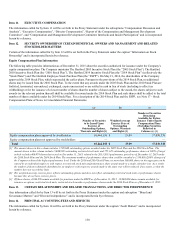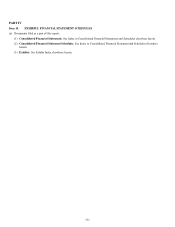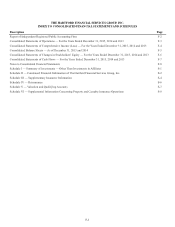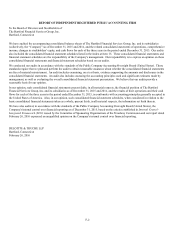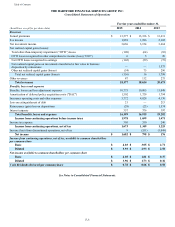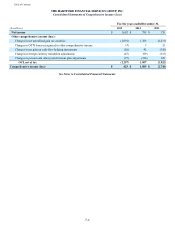The Hartford 2015 Annual Report Download - page 125
Download and view the complete annual report
Please find page 125 of the 2015 The Hartford annual report below. You can navigate through the pages in the report by either clicking on the pages listed below, or by using the keyword search tool below to find specific information within the annual report.125
Risk-Based Capital
The Company's U.S. insurance companies' states of domicile impose risk-based capital (“RBC”) requirements. The requirements
provide a means of measuring the minimum amount of statutory capital appropriate for an insurance company to support its overall
business operations, based on its size and risk profile. Regulatory compliance is determined by a ratio of a company's total adjusted
capital (“TAC”) to its authorized control level RBC (“ACL RBC”). Companies below specific trigger points or ratios are classified
within certain levels, each of which requires specified corrective action. The minimum level of TAC before corrective action
commences (“Company Action Level”) is two times the ACL RBC. The adequacy of a company's capital is determined by the ratio of a
company's TAC to its Company Action Level, known as the "RBC ratio". All of the Company's operating insurance subsidiaries had
RBC ratios in excess of the minimum levels required by the applicable insurance regulations. On an aggregate basis, The Company's
U.S. property and casualty insurance companies' RBC ratio was in excess of 200% of its Company Action Level as of December 31,
2015 and 2014. The RBC ratios for the Company's principal life insurance operating subsidiaries were all in excess of 400% of their
respective Company Action Levels as of December 31, 2015 and 2014. The reporting of RBC ratios is not intended for the purpose of
ranking any insurance company, or for use in connection with any marketing, advertising or promotional activities.
Similar to the RBC ratios that are employed by U.S. insurance regulators, regulatory authorities in the international jurisdictions in
which The Company operates generally establish minimum solvency requirements for insurance companies. All of The Hartford's
international insurance subsidiaries have solvency margins in excess of the minimum levels required by the applicable regulatory
authorities.
Sensitivity
In any particular year, statutory capital amounts and RBC ratios may increase or decrease depending upon a variety of factors. The
amount of change in the statutory capital or RBC ratios can vary based on individual factors and may be compounded in extreme
scenarios or if multiple factors occur at the same time. At times the impact of changes in certain market factors or a combination of
multiple factors on RBC ratios can be counterintuitive. For further discussion on these factors and the potential impacts to the life
insurance subsidiaries, see MD&A - Enterprise Risk Management, Financial Risk on Statutory Capital.
Statutory capital at the property and casualty subsidiaries has historically been maintained at or above the capital level required to meet
“AA level” ratings from rating agencies. Statutory capital generated by the property and casualty subsidiaries in excess of the capital
level required to meet “AA level” ratings is available for use by the enterprise or for corporate purposes. The amount of statutory capital
can increase or decrease depending on a number of factors affecting property and casualty results including, among other factors, the
level of catastrophe claims incurred, the amount of reserve development, the effect of changes in interest rates on investment income and
the discounting of loss reserves, and the effect of realized gains and losses on investments.
In addition, the Company can access the $500 Glen Meadow trust contingent capital facility and maintains the ability to access $1.0
billion of capacity under its revolving credit facility.
Contingencies
Legal Proceedings — For a discussion regarding contingencies related to The Hartford’s legal proceedings, please see the information
contained under “Litigation” and “Asbestos and Environmental Claims,” in Note 12 - Commitments and Contingencies of the Notes to
Consolidated Financial Statements and Part II, Item 1 Legal Proceedings, which are incorporated herein by reference.
For a discussion of terrorism reinsurance legislation and how it affects The Hartford, see MD&A - Enterprise Risk Management,
Insurance Risk Management, Terrorism Risk.
Tax proposals and regulatory initiatives which have been or are being considered by Congress and/or the United States Treasury
Department could have a material effect on the insurance business. These proposals and initiatives include, or could include, new taxes
or assessments on large financial institutions, changes pertaining to the income tax treatment of insurance companies and life insurance
products and annuities, repeal or reform of the estate tax and comprehensive federal tax reform, and changes to the regulatory structure
for financial institutions. The nature and timing of any Congressional or regulatory action with respect to any such efforts is unclear.
Legislative and Regulatory Developments
Dodd-Frank Wall Street Reform and Consumer Protection Act of 2010 (the “Dodd-Frank Act”)
Since it was enacted in 2010, the Dodd-Frank act has resulted in significant changes to the regulation of the financial services industry,
including changes to the rules governing derivatives, restrictions on proprietary trading by certain entities, the creation of a Federal
Insurance Office within the U.S. Treasury, and enhancements to corporate governance rules, among other things. The Dodd-Frank Act
requires significant rulemaking across numerous agencies within the federal government. Rulemaking and implementation of newly-
adopted rules is ongoing and may affect our operations and governance in ways that could adversely affect our financial condition and
results of operations.

















